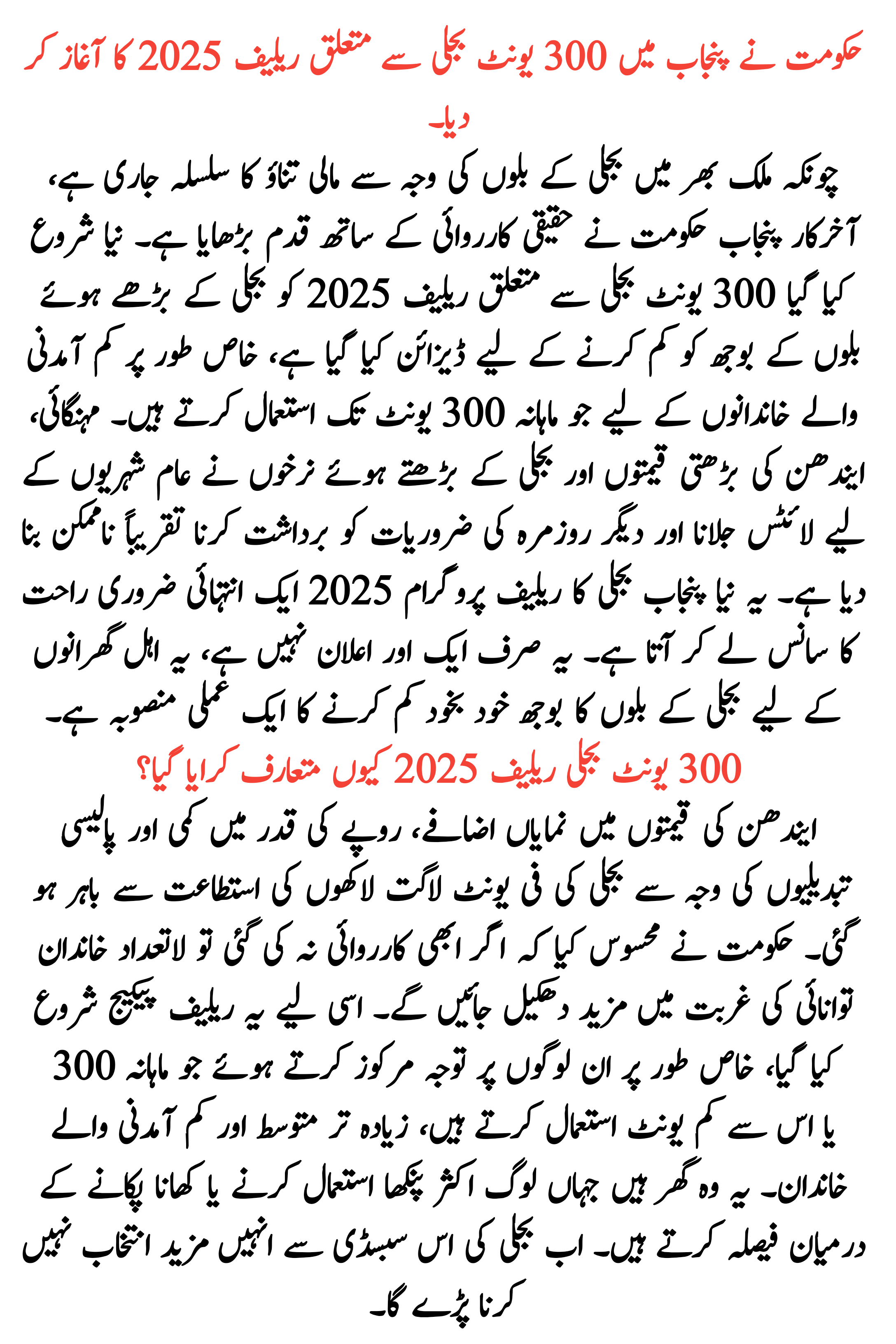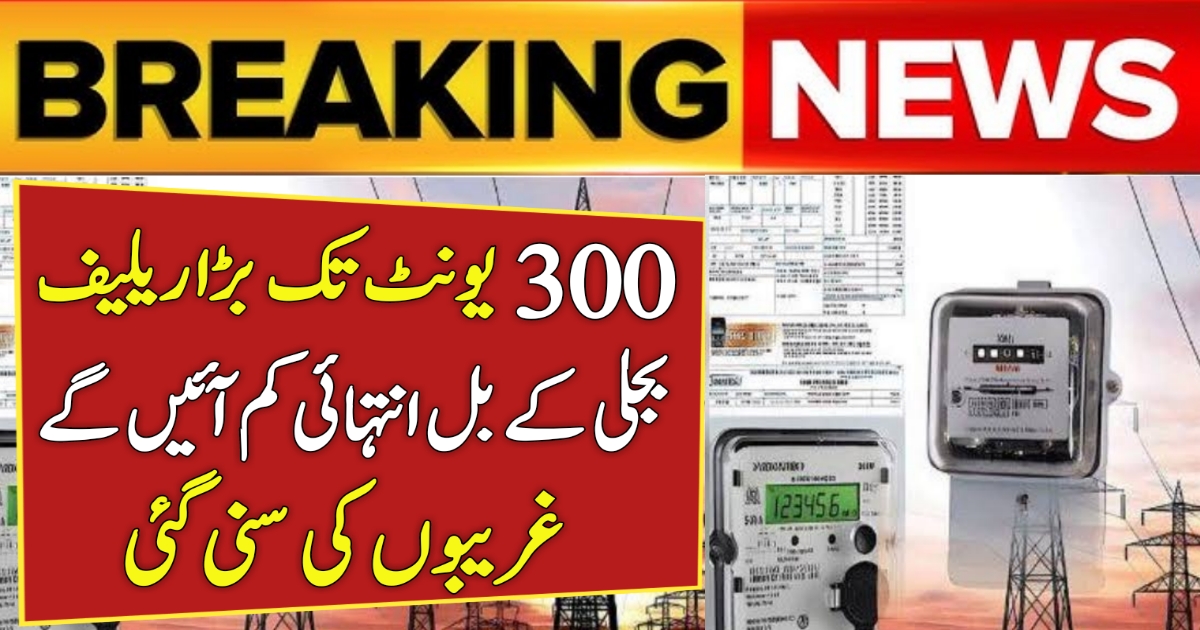As electricity bills continue to create financial stress across the country, the Punjab government has finally stepped forward with real action. The newly launched 300-Unit Electricity Relief 2025 is designed to ease the burden of inflated electricity bills, especially for low-income families using up to 300 units per month.
Inflation, rising fuel costs, and increasing electricity tariffs had made it almost impossible for ordinary citizens to keep the lights on and still afford other daily needs. This new Punjab electricity relief program 2025 brings a much-needed sigh of relief. It’s not just another announcement, it’s a practical plan to reduce the load of electricity bills automatically for eligible households.
Table of Contents
Why Was 300-Unit Electricity Relief 2025 Introduced?
Due to a significant hike in fuel prices, rupee devaluation, and policy changes, electricity per unit cost went beyond affordability for millions. The government realized that if action wasn’t taken now, countless families would be pushed further into energy poverty.
That’s why this relief package was launched, especially focusing on those who consume 300 or fewer units per month, mostly middle- and lower-income families. These are the homes where people often decide between using a fan or cooking food. Now, with this electricity subsidy, they won’t have to choose anymore.
Read More: BISP Kafalat BVS Issues Fingerprint

What Kind of Relief Will You Get?
| Monthly Consumption | Relief/Discount |
| Up to 200 Units | 50% Bill Discount |
| 201–300 Units | 30% Discount |
New Electricity Tariff Rates (July 2025)
| Units Used | New Rate (PKR) |
| 1–300 | Rs. 33/unit |
| 301–400 | Rs. 38/unit |
| 401–500 | Rs. 40.42/unit |
| 501–600 | Rs. 41.62/unit |
| 601–700 | Rs. 42.60/unit |
| 701+ | Rs. 47.69/unit |
Who Can Avail This Relief?
To be eligible for the 300-Unit Relief 2025, you must:
- Be a resident of Punjab
- Consume less than 300 units monthly
- Have a registered consumer number
- Not be involved in power theft
- Belong to a low-income household
Special priority will be given to BISP recipients and daily wage earners, ensuring that the most vulnerable benefit first.
Read More: Check Your Himmat Card Status via SMS
How Much Will You Save?
With this program, Punjab families can save anywhere between Rs. 1,500 to Rs. 3,000 per month. That could be used to buy groceries, medicines, or school fees, essential items that often get sacrificed due to high electricity bills.
Top Benefits of the 300-Unit Electricity Relief 2025:
- Immediate cost reduction for millions of households
- Financial breathing space for working-class families
- Encourages energy-efficient usage
- Restores public trust in government welfare programs
- Uses smart billing and automatic subsidy system.
Read More: Free Electric Bikes Scheme
Previous Electricity Relief Programs in Pakistan
| Year | Program Name | Beneficiaries | Type of Relief |
| 2020 | COVID-19 Bill Payment Support | All Pakistan | Deferred billing |
| 2021 | Lifeline Consumer Subsidy | Below 50 units | Rs. 3/unit subsidy |
| 2023 | K-Electric Rebate | Karachi, <300 units | 20–30% discount |
| 2025 | 300-Unit Relief (Punjab Only) | <300 units/month | Up to 50% discount |
What’s Next? What Should You Do?
You don’t need to apply, the relief is automatically added to your bill if you qualify. However, the government is planning:
- Awareness campaigns
- SMS tracking systems
- A relief portal for checking eligibility
- NADRA and BISP verification
- Complaint handling via local bodies
FAQs
Q1: When will this relief start?
It began on July 1st, 2025, across Punjab.
Q2: Do I need to apply?
No. If you qualify, you’ll get the discount automatically.
Q3: How to know if I’m eligible?
Check your average usage. If it’s under 300 units and your bill shows a registered CNIC, you’re in.
Read More: Documents for CM Punjab Green E-Taxi Scheme
Final Thoughts
The 300-Unit Electricity Relief 2025 is not just a policy, it’s a lifeline for Punjab’s struggling families. It shows what real governance can look like when it’s focused on the people. With automatic discounts, fair eligibility, and a digital tracking system, this initiative could change how government support reaches homes. Let’s hope it expands even further.

